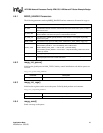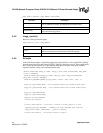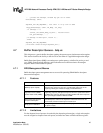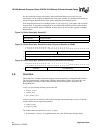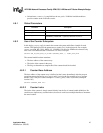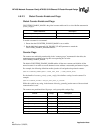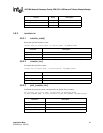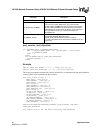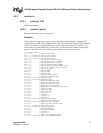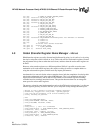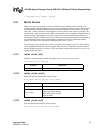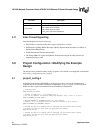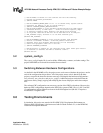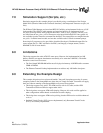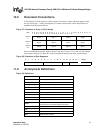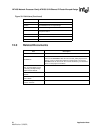
IXP1200 Network Processor Family ATM OC-3/12/Ethernet IP Router Example Design
52 Application Note
Modified on: 3/20/02,
237:[42]: 0 ETHER_RX_PACKET_ENQUEUE_ETHER
238:[43]: 1805817712 ATM_TX_CRC_PDU_DQ
239:[44]: 1688091717 ATM_TX_CRC_PDU_ENQ
240:[45]: 1688086138 ATM_RX_CRC_PDU_DQ
241:[46]: 1688086138 ATM_RX_CRC_PDU_ENQ
242:[47]: 0 ATM_RX_IPR_FULLQ
243:[48]: 0 ATM_RX_CRC_CHK_FULLQ
244:[49]: 1510539591 ATM_TX_CRC_GEN_FULLQ
245:[50]: 0 PACKETQ_SEND_BAD_BDA
246:[51]: 0 PACKETQ_SEND_BAD_INDEX
247:[52]: 0 BDQ_ENQUEUE_BAD_INDEX
248:[53]: 0 QUEUE_BAD_BDA
249:[54]: 0 ATM_RX_CRC_BAD_BD
250:[55]: 0 ATM_TX_CRC_BAD_BD
251:[56]: 1688087098 ATM_LOOPBACK forwarded packet with ATM dest to Ethernet
252:[57]: 0 Counter 57
253:[58]: 0 Counter 58
254:[59]: 0 Counter 59
192: 117726288 Total Packets Discarded
128:[port 8]: 68882072 PORT_FULLQ
138:[port 8]: 1 IP_BAD_CHECKSUM
144:[port 9]: 48844381 PORT_FULLQ
4.9 Global $transfer Register Name Manager - xfer.uc
SRAM transfer registers are easily allocated and deallocated by using .local/.endlocal, or by using
the xbuf.uc subsystem, which is based on .local. This works well for read transfer registers, because
the programmer always knows when the read is done, and thus when the read transfer register can
be freed.
However, write transfer registers are a different problem. While it is possible to use the same
mechanism as for read transfer registers, this requires waiting for writes to complete before re-
using the write transfer registers, and this wait may impact performance.
An alternative is to not wait for the write to complete, but to infer the completion of writes by their
order before subsequent reads in the ordered SRAM queue. The .local mechanism and xbuf.uc
require strict block structure, and are thus not well suited to write transfer registers becoming
available based on seemingly unrelated events. The question becomes then how to manage the
name space for write transfer registers.
The answer, at least for some implementations such as the ATM receive microengine, is to allocate
transfer registers globally, and to use the new xfer.uc subsystem to help manage the name space.
// Macros to aid in manually allocating transfer registers.
// Essentially wrappers for .xfer_order, .operand_synonym
// that use the pre-processor to do as much assembly-time
// sanity checking as possible.
// API
// xfer_init(NUM_READ_WRITE)
// xfer_reserve(NAME, POSITION, FLAGS)
// xfer_free(NAME, POSITION, FLAGS)
// Example:
// xfer_init(1) ;; use 1 of 8 $transfers
// xfer_reserve($foo, 0, XFER_RESERVE_READ | XFER_RESERVE_WRITE)
// sram[write, $foo], ordered
// sram[read, $foo], ordered, ctx_swap
// xfer_free($foo, 0, XFER_RESERVE_WRITE)
// xfer_reserve($bar, 0, XFER_RESERVE_WRITE)
// sram[write, $bar], ordered



